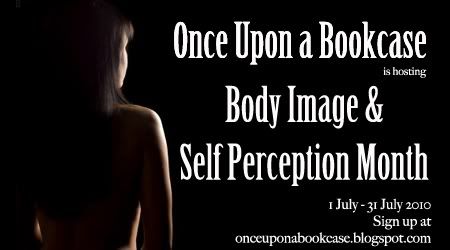This post includes what I consider to be minor spoilers for the books I have reviewed and will be reviewing for Body Image and Self-Perception Month. As this post is about the causes of body image issues as presented in the novels, I don't go into the plots too much.
Why do people judge themselves so harshly for the way they look? Today I am going to list all the reasons I could find in the novels that I have read for Body Image and Self-Perception Month and compare the approaches taken by different authors to these subjects. One of the things I have really liked about this month is reading such a diverse range of books, with different styles, priorities, and approaches to the subject.
So what have authors chosen to highlight as causes of low self-esteem and negative body images?
Cultural standards of beauty
Even if the subject is not directly addressed within the story, the protagonists in every single book that I have read know what the cultural ideal for beautiful is and judge themselves for not living up to it. Every time a character decides that they are fat, ugly or otherwise unattractive and abnormal, they are comparing themselves with this ideal.
Some of the characters judge practically everyone they meet by this ideal, others only judge themselves. Virginia in
The Earth, My Butt and Other Big Round Things
cuts out pictures of thin models to stick on the fridge, to torment herself into keeping to her diet, but she doesn't say or think anything judgemental about other people, she just wants to fit into her apparently perfect family. When Leslie (
Second Star to the Right
) develops anorexia nervosa, she becomes so convinced that other people are thinner than her that she can't believe them when they point out that they're not.
On the other hand, Troy in
Fat Kid Rules The World considers his Dad too big (but he gets away with it because of his job), his brother perfect, and Curt too skinny. Colie of
Last Chance
divides the world into thin girls and fat girls, and is confused by the fact her aunt Mira isn't interested in dieting or trying to become thin herself. Syrah from
Girl Overboard starts off looking at everyone through this lens as well, marvelling at the fact that Chelsea has the status of Queen Bee at school despite looking like "Barbie after bingeing on a one-month ice-cream diet". In
Everything Beautiful, Riley seems to have three categories in which to put people - a) pretty and cool by cultural standards b) uncool and c) cool by her standards. I think this is particularly interesting because I've always had a similar sort of appreciation for the glamourous type of weird. It shows how even when you're into your own things and don't have much interest in fitting in yourself you remain aware of what other people - who do stick to the cultural norm, or to what's considered cool - consider normal or beautiful.
Maria, Carmen's mother in
Massive
, is the most tragic example of a character whose entire world view has been shaped by the idea that to be thin is to be beautiful. She is utterly convinced that being thin is the only way to be, believing that if you are thin you will be successful, the world will love you. She is disgusted by anyone who doesn't aspire to thinness and tries to force her views onto Carmen. Barbie's mother in
I Was a Teenage Fairy
has a similar faith in beauty standards, having failed to become a successful model after winning a beauty pageant in her youth, it is her dream to have Barbie follow the path she tried to take. She assumes that Barbie is as interested in modelling as she is, and won't listen to anyone who criticises her for dragging her daughter to agencies, beauticians, and photographers.
Being compared or comparing themselves with family members
Several of the books I've read for this themed month have featured protagonists who feel that they don't really belong to their families because of the way they look.
Blood Ties and
Jumping to Confusions
feature girls who are compared unfavourably by their parents and other people to their sisters. In both these books, the sister is actually a twin.
Blood Ties' Rachel was actually cloned from Rebecca, who died before she was born. Rachel's parents don't mean to make Rachel feel like she is worth less than her sister was, but their house is full of pictures of Rebecca, beautiful and successful, and I think that the very fact they chose to clone Rebecca rather than have another child naturally or adopt shows how attached they were to the idea of their perfect first child. In
Jumping to Confusions, Cat's non-identical twin Tessa is slimmer than her and popular with boys, and their Mum seems to prefer Tessa, although their Dad thinks that Cat is just as beautiful. Cat has fallen under Tessa's spell so much that she can't see when she's being taken advantage of by her sister.
Virginia in
The Earth, My Butt, and Other Big Round Things feels like she doesn't fit into her perfect family, and they make matters worse by directly imposing their own standards of beauty onto her. Which brings me onto the subject of parents...
Parents
Virginia Shreves' parents and brother pretty much ignore her unless they want to discuss her weight. At the start of the book, her sister Anaïs takes a break from university to join the Peace Corps, which leaves Virginia at the mercy of her parents' opinions without a dissenting voice to help her.
In
Girl Overboard Syrah's mother is constantly worrying about Syrah's appearance, telling her what to eat and not eat. Maria in
Massive also puts her daughter on a diet. These stories show how horrible it can be when someone is under this kind of pressure from their parents, in addition to having to deal with the expectations of society in general. I feel that the books in which parents are partly responsible for their children's body issues tend to be more serious - if a child has support at home then it's much easier to face the judgemental world.
I will talk about the influence of families in more detail in my guest post for
Once Upon a Bookcase.
Peer Pressure
Carmen pretty much has it coming at her from all sides - bullies at school start to pick on her because of her size.
Last Chance's Colie is also bullied for being overweight, until she becomes slim, and then the insults become sexual. Rachel in
Blood Ties has no friends and
attracts the unfortunate attention of her school's bunch of mean girls, who talk about her weight and how unattractive to boys they think she is, but Rachel has pretty much accepted the way she is and the bullying as a sad fact of life. Troy from
Fat Kid Rules The World is also a social outcast until Curt comes into his life.
Boys
One thing I noticed in most of these books is that the boys and men that the female protagonists interact with are very nice and non-judgemental of the way the girls look. Girls worry that boys don't/won't fancy them because they're overweight, but they've apparently got this idea from the media, not from real life experience. Virginia's dad is pretty much the only male character that expresses the opinion that skinny women are more attractive. It's other women or girls doing the bullying or judging in the other books.
On one level, I think this is great because it is true that men haven't been brainwashed en masse to find nothing but blonde, skinny women with big breasts attractive. But on another, I'm mystified - where were all these appreciators of female diversity when I was growing up?
Which of these causes of negative self-perceptions and body image issues do you think is the most important? I think that the cultural beauty standard has the most to answer for as it really influences all the other factors. If being overweight wasn't presented as wrong, then it's unlikely that there would be the same amount of parental and peer pressure.
Have you noticed any more in these or in other books? Were the boys you knew that nice?!






